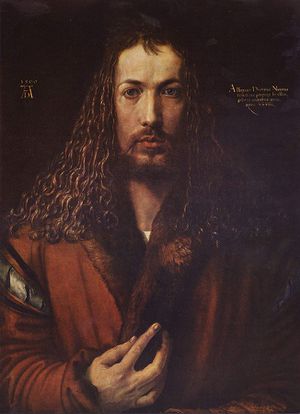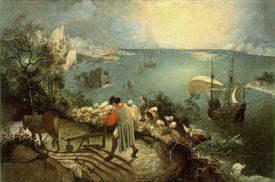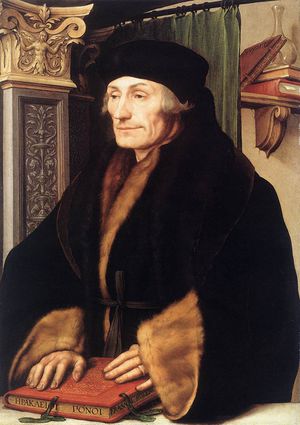Difference between revisions of "What were the causes of the Northern Renaissance"
| Line 48: | Line 48: | ||
The Northern Renaissance could not have developed without the region's growing peace and prosperity, especially after the difficult 14th century. This allowed members of the elite to become the patrons of writers and artists. Then there was the invention of the printing press, which made the works of the writers from the past known to many more people, and this did much to propagate the values and beliefs of the Northern Renaissance. Changes in society, such as the decline in feudalism, meant a growing willingness to accept new ideas and beliefs. The rising urban elites and national monarchies in England and France were very willing to adopt the Renaissance's ideals. | The Northern Renaissance could not have developed without the region's growing peace and prosperity, especially after the difficult 14th century. This allowed members of the elite to become the patrons of writers and artists. Then there was the invention of the printing press, which made the works of the writers from the past known to many more people, and this did much to propagate the values and beliefs of the Northern Renaissance. Changes in society, such as the decline in feudalism, meant a growing willingness to accept new ideas and beliefs. The rising urban elites and national monarchies in England and France were very willing to adopt the Renaissance's ideals. | ||
| − | |||
<div class="portal" style="width:85%;"> | <div class="portal" style="width:85%;"> | ||
Revision as of 20:36, 17 December 2020
The Italian Renaissance had placed human beings at the center of life and had promoted secular values instead of religious ones. Influenced by the ancient past's ideas, it conceived of a new way of life and provided a new worldview. The Renaissance was a period of great works of art, literature, and philosophy. The Renaissance of 're-birth' was not just confined to Italy. There was also a Northern Renaissance. This is the term given to the cultural flowering north of the Alps, in German-speaking countries, the Lowlands, France, and England. Although influenced by the Italian Renaissance, the Northern Renaissance was a unique event and was distinct from it. This article will argue that the origins of the Northern Renaissance resulted from the spread of printing, Italy's influence, growing wealth, and the decline of the culture associated with feudalism.
The Northern Renaissance
The Northern Renaissance was similar to the Italian Renaissance. It also was interested in the ancient past and believed that it was a guide to the present day. The Northern Renaissance was also very much concerned with humanism and its values.[1] This was the idea that humans with the use of their reason could improve their circumstances and their society. It was more concerned with the individual. The movement believed in the possibility of human freedom and the perfectibility of man.
However, the Northern Europe Renaissance was much more religious in its nature than the Italian Renaissance. Many Northern scholars, such as Erasmus, were very much interested in the reform of the Church. They denounced superstitions and clerical abuses and corruption in the name of the true faith.[2] The great scholar Erasmus was born in the modern-day Netherlands, was religious and also very interested in the classical world.
However, like many other German and other Northern Humanists, he saw no contradictions between Christianity and ancient cultures and believed that they could be reconciled. The religious character of the Renaissance north of the Alps was due in part to the continuing influence of the Church, unlike in Italy, where the Church was in decline.[3] The Northern Renaissance was an impressive cultural epoch whose achievements were as great as those in Italy. It produced writers of the stature of Rabelais, Montaigne, Erasmus, and Thomas More.
In the arts, it also was a time that saw many masterpieces by artists such as Durer and Bosch. The Northern Renaissance humanists were not just concerned with the study of ancient texts but also the bible. Scholars began to study the bible in a new and critical way. Scholars produced more reliable versions of key biblical texts and produced commentaries on the New and Old Testament. These were very influential, and the Northern Humanists ‘New Learning’ inspired many to question the Church's teachings and authority, which did much to pave the way for the Reformation[4]
Socio- Economic Background
The fifteenth and sixteenth century was a period of economic recovery for much of Northern Europe after the wars, plagues, and instability of the 14th century. Trade recovered, and new trade routes were established. Many cities became fabulously rich in the Rhineland and the Lowlands.[5] Many cities became very rich, especially those in modern Belgium such as Bruges. This period also saw stability and peace in Northern Europe as the great wars of the 14th century, such as the One Hundred Year War, ended. This and the economic expansion meant that there were more schools and Universities in Northern Europe.[6] The growing stability of Europe after the trials of the 14th century meant that there was more contact between Northern and Southern Europe, and ideas were transmitted from the Mediterranean region to the North. The growing wealth of the region was to be very important in the rise and the achievements of the Northern Renaissance.[7]
This is because it allowed the local elites to patronize artists and scholars. In this era, artists and writers could not live and work without the support of the wealthy. The wealth of the elite in Northern Europe meant more patrons for artists and writers, which allowed them to create their masterpieces. The Northern Renaissance origins are associated with the Duke of Burgundy, who was among the art's greatest patrons in the early years of the Northern Renaissance. The Dukes owned a vast territory stretching from Switzerland to Belgium.[8] They were de-facto independent of the German Holy Emperor and the French King. Successive Dukes were great patrons of the arts. They commissioned many great works of art.[9]
The Burgundian Court played a major role in their patronage in developing Renaissance art and values in Northern Europe. Many wealthy merchants at this time also acted as the patrons of many artists. This was especially the case in the great Flemish cities in modern-day Belgium, such as Antwerp and Bruges. Wealthy merchants often commissioned works from local artists, which allowed a great school of Flemish painters to flourish. The Church and the monarchies were also important patrons of the art. For example, Francis II of France was a great patron of the arts, and he spent lavishly on paintings and various artworks and even brought the great Leonardo Da Vinci to his court. Without the elites' patronage, the Northern Renaissance would not have produced as many great cultural works.[10]
Influence of Italy
In Italy, the city-states were a remarkable artistic and intellectual flowering scene since the late Medieval Period. The renaissance was an effort to imitate the lost world of ancient Greece and Rome. The Italian artists, writers, and thinkers who all participated in the Renaissance sought to create works that were the equal of the Greeks and Romans, whom they regarded as the pinnacle of civilization. The ideas and the works of the Italian Renaissance soon became known north of the Alps. It was only in the late fifteenth century that ideas from Italy only slowly made their way north. In the 1490s Charles, the VIII of France invaded Italy to claim the Crown of the Kingdom of Naples.[11]

The invasion and later wars exposed many in the French nobility, who served as officers in the army to the Italian Renaissance ideas. In turn, they transmitted Italian culture to the rest of Europe. Then many students from Northern Europe came to study in Italy at great Universities such as Bologna. Here they were exposed to the Renaissance ideas, and they returned home and helped spread them in their native lands.[12] More and more northerners traveled to Italy, many such as Albert Durer, the great German artists, traveled to study the art of the great Italian painters, which greatly influenced his style and was the inspiration between many of his greatest works. All of these contacts helped to make the Italian Renaissance ideas better known in the north and inspired many humanists and artists to take a new approach in their work. They soon had absorbed the new conception of life that they had witnessed in Italy and related it to their own societies and times.[13]
Influence of Printing
Italy's ideas would have been confined to a small elite in Northern Europe but for the invention of printing. The basic printing elements had been known in China for centuries, and papermaking had been introduced to Europe in the 13th century. However, in the 1440s, there was a decisive step forward in the development of printing. In Mainz, Germany, Johann Gutenberg and other printers invented movable type by cutting up old printing blocks to form individual letters.[14] It seems that Gutenberg and other printers' invention was based on the wine presses in this wine-growing region. Soon Gutenberg was able to mass-produce books and documents on an unprecedented scale. Gutenberg used movable type to produce the first printed version of the Bible in 1454. The printing press was a sensation at the time, and it changed European society. Before, these books were rare and not freely available as most were produced by hand by professional copyists, who were usually monks and prioritized devotional literature.
Suddenly books that were once a rarity became widely available, especially to affluent traders and professionals in urban centers. Soon all the major European countries had printing presses, and they were producing bibles, devotional works, and significant works by classical authors such as Virgil.[15] The new books on classical authors exposed more people to the ideas of the past and especially the classical period. These works greatly stimulated Northern Europe's intellectual life and did much to inspire intellectuals to revive the wisdom and knowledge of the ancient past. The printing press also did much to spread key Northern Renaissance thinkers such as Thomas More.
Political and Social Changes
Northern Europe was undergoing a period of great cultural change. The old feudal nobility was under pressure, and their influence on the culture's culture was in decline. The era’s rising prosperity saw a new class of urban merchants, who had little regard for the old feudal nobility and values. The old culture based on feudalism promoted ideas of chivalry and deference were in decline, and people were more open to new ideas.[16]
The humanists’ ideas were received enthusiastically by the new urban elite of merchants and lawyers. They were drawn to the Italian humanists' values, which stressed reason and denied the primacy of received wisdom in the society. They also formed the audience for the books produced by the Northern Humanists such as Erasmus. Another factor in the changing culture was the rise of national monarchies in France and England.[17]
In many northern kingdoms, the monarchies were centralizing power, and the feudal nobility was being weakened. They were being reduced from the status of semi-independent rulers to dependents of the monarch. The rise of the national monarchies meant that increasingly that cultural life was focused on the court. The monarchs of England and France, in particular, were very receptive to the ideas of the Renaissance. They arguably used the Renaissance ideas to justify and legitimize their increasing role in society and their growing powers.[18]
They exploited the cultural productions of the Renaissance to publicize their special position in society. For example, Francis II was a lavish patron of the arts to symbolically demonstrate his privileged status in French society, especially concerning the nobility. Typically, the nobles imitated the king, which led to a growing interest in the new styles of art produced during the Northern Renaissance. This did much to spread the values of the Renaissance throughout France, England, and beyond.
Conclusion
The Italian Renaissance deeply influenced the Northern Renaissance, but it was not merely an imitation of it. The Renaissance north of the Alps was much more religious than the largely secular and pagan Renaissance in the south, and it arguably laid the intellectual foundations of the Reformation. The Northern Renaissance was inspired by the ideas that flourished in the city-states such as Florence and Venice.[19]
The Northern Renaissance could not have developed without the region's growing peace and prosperity, especially after the difficult 14th century. This allowed members of the elite to become the patrons of writers and artists. Then there was the invention of the printing press, which made the works of the writers from the past known to many more people, and this did much to propagate the values and beliefs of the Northern Renaissance. Changes in society, such as the decline in feudalism, meant a growing willingness to accept new ideas and beliefs. The rising urban elites and national monarchies in England and France were very willing to adopt the Renaissance's ideals.
Related DailyHistory.org Articles
References
- ↑ Giustiniani, Vito. "Ho, mo, Humanus, and the Meanings of Humanism," Journal of the History of Ideas 46 (vol. 2, April – June 1985): 167 – 95
- ↑ Giustiniani, p. 187
- ↑ Giustiniani, p. 187
- ↑ Huizinga, Johan. Erasmus and the Age of Reformation, with a Selection from the Letters of Erasmus, in series, Harper Torchbacks, and also in The Cloister Library. (New York: Harper & Row, 1957), p. 13
- ↑ Chipps Smith, Jeffrey The Northern Renaissance Phaidon Press, 2004), p. 56
- ↑ Chipps, p. 5
- ↑ Huizinga, p. 15
- ↑ Huizinga, p. 25
- ↑ Chipps, p. 18
- ↑ Chipps, p. 117
- ↑ Holt, Mack P. Renaissance and Reformation France: 1500-1648 (The Short Oxford History of France. 2002), 89
- ↑ Holt, p. 113
- ↑ O'Neill, J, ed. (1987). The Renaissance in the North (New York: The Metropolitan Museum of Art), p. 114
- ↑ Holt, p. 115
- ↑ Burke, Peter. The Italian Renaissance: Culture and Society in Italy (Princeton: Princeton University Press, 1999), 6
- ↑ Burke, p. 115
- ↑ Burke, 134
- ↑ Janson, H.W.; Anthony F. Janson. History of Art (5th, rev. ed.). New York: Harry N. Abrams, Inc. 1997), p. 113
- ↑ Huinzinga,.56
Admin, Ewhelan and EricLambrecht


